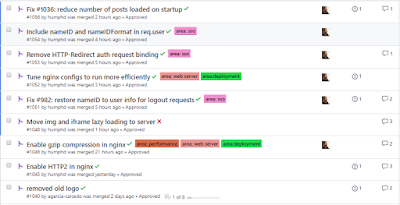We've finally hit 1.0 for Telescope. What a journey.
I finished up the issues I was still working on from 0.9 and worked on a few more:
PR #919: Feed Type Should Support Delete, Modify (Delete + Create)
Overall, I did not expect the whole "add feed" feature to be this big. We had 4-5 people working on this. 3 on the back-end, 1 on the front-end and our prof helping out on both ends. Happy to say we have it working. My PR was working as expected, but it wasn't doing great performance-wise due to multiple Promise.all() and awaits, with help from our prof, we were able to get rid of a lot of them. I learned if you want to trigger our prof, wrap a Promise.all() within another Promise.all().
PR #931: Add a Way to Receive Updates when New Posts are Available
PR is done, I'm beginning to regret mentioning I wanted to work with React.
PR #937: Finish Search Feature
This PR was possible because I learned a few things from reviewing a PR by
@Silvyre. Seriously, if you want to be a better developer, look into doing code reviews, you'll widen your perspective.
PR #989: Teach tools/autodeployment/server.js about a release to master
Our staging box auto deploys itself whenever there is a change in the master branch. We wanted to change it up for production so it will only auto deploy itself whenever there is a tagged release. One of the things I have neglected during my years at Seneca is scripting or just using linux commands. I've started on the path of slowly redeeming myself with this PR.
PR #993: Remove "feed added successfully" after some period
Front end change, this uses the SnackBar component implemented in #931 to display a toast informing the user if their feed has been added
Wrapping Up
I started this journey in OSD600 where our first assignment was to create a notepad app (I did the bare minimum) and trying to enhance or debug other students' implementation of it on Github, I even remember I had issues writing the notepad app. Back then, I could not imagine contributing to building a project from the ground up (Telescope)... I could barely fix an issue a week to keep up with Hacktoberfest during that time.
Now that OSD700 is about to wrap-up, I've noticed how much my attitude and skill changed:
We have to implement a new tool for Telescope? No problem, time for some experimenting.
There's a new component that needs to be built? Front-end huh... but I'm game.
New issues dealing with a tool that has been implemented but I haven't used yet? Pick me!
Nginx issues? Oh god. where's
@manekenpix to hold my hand through this?
Overall this course and project was extremely fun. We worked like a team you would find in a workplace, we had dev-ops, back-end devs, front-end devs. We got to explore and experiment with different tools we normally wouldn't get a chance to work with all at once: ElasticSearch, Redis, Kubernetes(lol), Gatsby, GraphQL, Nginx, Docker, Jest, SSO. It did not matter if we were not able to implement them in the project. Just the opportunity to experiment with it has improved my knowledge with it, which I am very grateful for.
I think why these open source classes were so fun was because all the things we were doing were open ended. These were real world issues, there is no answer guide for us to take a look at when we were stuck. Sometimes even our prof was reading API or tool docs to understand and help us out when we were stuck on our PRs.
Lastly, I do not think this would have been possible without our prof and lead
@humphd, he's a monster. Deployment, back-end, front-end, authentication, system + architecture design, he is knowledgeable in it all. He can and will request changes on your PR which you spent hours working on. As of writing, we have ~468 closed PRs, of which he has probably reviewed close to that same number of them. Thank you for guiding us.
In no particular order it was a blast working with you guys. Thank you
@manekenpix,
@cindyledev,
@Silvyre,
@agarcia-caicedo,
@grommers00,
@miggs125,
@lozinska,
@yatsenko-julia
Other students at Seneca, if you have a chance to take OSD600/OSD700. Please do. This is probably the highlight of your program.









